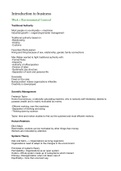Introduction to business
Week 1 (Environmental Context)
Traditional Authority
Most people on countryside—>machines
Industrial growth—>organizing/smarter management
Traditional authority based on
-Relationship
-Kinship
-Customs
Favoritism/Particularism
Hiring and firing because of sex, relationship, gender, family connections
Max Weber wanted to fight traditional authority with:
-Formal Rules
-Hierarchy
-Authority of office/position
-Division of labor
-Systematic pay structure
-Separation of work and personal life
Downside:
Fixed on the rules
Bureaucratism makes organizations inflexible
Creativity is downplayed
Scientific Management
Frederick Taylor
Homo Economicus= a rationally calculating machine, who is narrowly self-interested, desires to
possess wealth and is mainly motivated by money
-Efficient working, man like machines
-Separation of thinking and doing
-Thinking done by science
Taylor: time and motion studies to find out the quickest and most efficient motions.
Human Relations
Elton Mayo
Rest breaks, workers can be motivated by other things than money.
Workers are motivated by attention.
Systems Theory
Katz and Kahn—> Organizations as living organisms
Organizations need to adept to the changes in the environment
Principles of systems theory
Permeability= Organizations as an open system
Holism= Whole system made up of subsystems which interact
Entropy= Disorganization when not taken care of
Equifinality= more than one best way
,Contingency theory= how does the organization fit the environment?
Network theory
The invention of the computer and the position of the Detroit car industry shaped this theory.
Organizations are like networks, with relationships among independent and self-organizing units.
Example Toyota= improving all functions and involving all employees of the internal network.
The pendulum swings back and forth between structure and behaviors and between closed and
open systems. Between parts and the whole.
Week 2
Companies have to keep a close eye to:
Technological changes
Economic developments
Societal changes
Growing importance climate change
The environmental context
The macro environment:
-Technological context (innovation, new products, processes business concept
-Political context (rules, sanctions, requirements import duties
-Economic context (international/national developments in the economy)
-Social-cultural context (diversity, inequality)
-Climate & ecology (environment and the change in it)
The environment defines opportunities and survival, therefore companies need to constantly
monitor the environment.
Technological context
Digitalization leads to new business processes, new products and services and companies and
also lead to the disappearance of them, companies need to adapt to these developments to
remain in the long run.
Political and economic context
Policies an actions of local, national and supranational authority
Governments impose rules and regulations, taxes and subsidies
Government control cross-border business activities
Politics has economic impact, f.e. Iraq war, Brexit and US trade policy
Consistency in policy and clear rules make a positive investment climate in which companies dare
take risks and invest.
Political tensions between countries negatively affects the international economic context
Social-cultural and ecological context
Recent important social developments, f.e. #Metoo and BlackLives Matter
Climate and environments are becoming increasingly important to companies
Covid-19 speeds up processes, more online than physical stores.
Influence our expectations regarding ethical behavior of companies and how we manage and
organize companies. Changes in the ecological context lead to higher costs for businesses and a
livelily more disruptive future.
Globalization: the global exchange of goods, services, capital, information, ideas and people.
Rapid spread of the virus because of international travel.
Rapid exchange of knowledge exchange on virus characteristics
What accelerated globalization?
-Political changes: liberalizations, opening up markets
, -International collaboration: trade agreements, international standards, international institutions
-Socio-cultural changes: cultural exchange via international travel, films and tv
-Technological factors: communication, information and transportation
Effects of globalization in:
Trade, international investments, international capital, circulation of knowledge, ideas and
information and circulation of people.
Rising inequality within countries.
Ecological damage because of globalization.
Globalizations or regionalization?
Multinationals as symbols of globalization
Multinationals are active in different countries and own foreign assets which they actively control
Multinationals have foreign offices or production locations in more than one country, are important
to the global economy and contribute substantially to the growth of world trade and increasingly
originate from non-western countries.
Week 3
How do institutions develop?
Institutions have a good influence
Changing institutions is difficult
Change the rules, rule the market
Pandemic shows weaknesses and shows creation of new institutions
What are institutions?
The rules of the game
Formal, explicit rules, laws, formula agreements
Informal, tacit understandings, broadly shared expectations, norms
Formal institutions—> regulatory pillar
Informal institutions—> normative+cognitive pillar
What do institutions do?
1. They structure political, economical and social interactions and reduce uncertainty.
Clear rules are in place to facilitate transactions and are determined by institutions.
Institutional isomorphism= the processes that force a unit within a population (institutional
context) to become more similar to other units with a similar institutional context.
Institutions come to the forefront in unfamiliar or changing context or when violating institutions.
2. Institutions shape economies
Like currency or property rights.
When people trust in their ownership of goods, they can reliably exchange properties.
Intellectual property rights= institution that monitor rip-offs
Corporate governments= rules to align managers interests with the interest of the shareholders
and other stakeholders.
Where do institutions come from?
Institutions are the humanly devised constraints that structure political, economic and social
interaction.
They can sometimes feel as superhuman, created by god himself instead of humans.
Institutions emerge within institutional frameworks through institutional work within institutional
spheres.
Institutional systems= political, economical and legal systems





